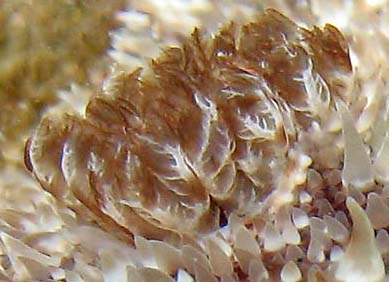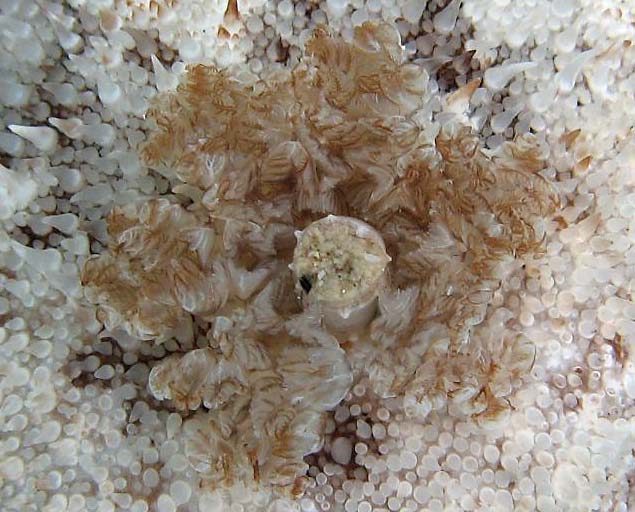This species has been observed on Reunion, Mauritius and Mayotte Islands
A relatively soft mantle, covered with numerous soft pointed tubercles, mottled with light brown colours and a few dark brown patches
|

|
|
| Showing species characteristics... | Photo Philibert Bidgrain Reunion, Etang salé on a rocky coast, 5 November 2006, size 100 mm |
|
See more about : Sightening and mating periods
See more about : Sebadoris nubilosa variability in Southwest Indian ocean
See more about : Sebadoris nubilosa swim...
Remarks :
Identification confirmed by Bill Rudman
Synonymous (according worms) :
- Archidoris nubilosa, (Pease, 1871) - Doris nubilosa, Pease, 1871
- Argus indicus, O.Donoghue, 1932 - Thordisa crosslandi, Eliot, 1903
- Diaulula gigantea, Bergh, 1905
Bibliographic data :
The underside of the mantle is translucent white with a distinct submarginal dark-brown band. Between this band and the body are scattered large brown spots. There are also numerous opaque white spots (see Sonia Ribes Beaudemoulin specimen). The sole of the foot are creamish white or yellowish with dark brown spots.
The dorsum is covered with large, dark, oval patches, which are larger in the centre of the dorsum. There are also numerous small opaque white spots.
The dorsum is covered with soft, thin and pointed papillae. Some of the papillae are larger than the rest, and have a elongate prolongation on the tip. Larger papillae are surrounded by several small ones.
The rhinophoral and branchial sheaths have small papillae, similar to those on the rest of the dorsum.
The small lamellate rhinophores are white with brown speckling and with white apices
Gills : The five tripinnate branchial leaves are creamish and brown, and they form a complete circle around the anus.
The animal can swim if disturbed by slow dorso-ventral flexions of the hole body. Swimming does not involve undulations of the mantle margin as Hexabranchus sanguineus
If disturbed it can autotomise the whole or part of the mantle skirt.
S. Nubilosa probably feeds on siliceous sponges
Otinodoris raripilosa could be confused with Sebadoris nubilosa but Sebadoris nubilosa has distinguishable, soft, dorsal papillae.
References :
Bill Rudman Seaslug site : Sea Slug Forum : Sebadoris nubilosa
Publications :
Valdes, A (2002), A phylogenetic analysis and systematic revision of the cryptobranch dorids (Mollusca, Nudibranchia, Anthobranchia). Zoological Journal of the Linnean Society, 136, 535-636
Dayrat B. (2010). A monographic revision of basal discodorid sea slugs (Gastropoda, Opisthobranchia, Nudibranchia, Doridina). Proceedings of the California Academy of Sciences. Series 4, vol. 61, suppl. I, 1-403, 382 figs.
Edmunds, (1971): Opisthobranchiate Mollusca from Tanzania (suborder Doridacea). Zoological Journal of the Linnean Society 50(4), 339-396. (Pl.1)
Marcus, Er. & Marcus, Ev. (1970) Opisthobranch mollusks from the southern tropical Pacific. Pacific Science , 24(2): 155-179
Kay, E.A. & Young, D.K. (1969) The Doridacea (Opisthobranchia: Mollusca) of the Hawaiian Islands . Pacific Science , 23(2): 172-231
Pease, W.H. (1871) Descriptions of new species of Nudibranchiate Mollusca inhabiting Polynesia . No.2. American Journal of Conchology . 7 (1): 11-19
Other photos of Sebadoris nubilosa :
Philibert Bidgrain Reunion, Etang salé on a rocky coast, 5 November 2006, size 100 mm On right : Gill's detail. The five tripinnate branchial leaves are creamish and brown, and they form a complete circle around the anus. The branchial sheath has small papillae, similar to those on the rest of the dorsum. Below : The underside of the mantle is creamish white with a distinct submarginal dark-brown band. Between this band and the body are scattered large brown spots. |
 |
 |
|
| >
Philibert Bidgrain Mayotte, Hamouro, plage du phare, less 1 m, 3 February 2012, size : 25-30 mm |
On this small spécimen from Mayotte Island: Juvénile tr local form of this species??? |
 |
 |
 |
Sonie Ribes Beaudemoulin Reunion, Trois Bassins lagoon, 5 m from the beach under a dead coral, 6 January 2008, size : more than 100 mm The five tripinnate branchial leaves are creamish and brown, and they form a complete circle around the anus.
|
The underside of the mantle is creamish white with a distinct submarginal dark-brown band. Between this band and the body are scattered large brown spots. There are also numerous opaque white spots (observed in this specimen). The sole of the foot are creamish white or yellowish with dark brown spots. |
 |
Philippe Bourjon Reunion, "la bobine", L'Hermitage , Saint Gilles, less 1 m, 29 May 2009, size : 160-200 mm Detail of one rhinophore : The rhinophoral sheaths have small papillae, similar to those on the rest of the dorsum.
|  |
Alain Barrère Reunion, On this specimen, the sole of the foot are creamish white with dark brown spots. |
|
 |
 |
More photos from Indian Ocean
See more about : Sebadoris nubilosa variability in Southwest Indian ocean
See more about : Sebadoris nubilosa swim...
Reunion, Sebadoris nubilosa, at Saint Leu, by Philippe Cao Van
Reunion, a very large S nubilosa, at Saint Gilles, by Hugues Flodrops
Reunion, S. nubilosa on Pavona cactus, at Saint Gilles, by Sonia Ribes Beaudemoulin
Reunion, Sebadoris nubilosa partially eaten, at Saint Leu, by Philippe Bourjon
Mauritius, Sebadoris nubilosa at Pointe d'Esny, by Geoffrey Summers
